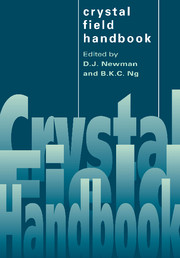Book contents
- Frontmatter
- Contents
- List of contributors
- Preface
- Introduction
- 1 Crystal field splitting mechanisms
- 2 Empirical crystal fields
- 3 Fitting crystal field parameters
- 4 Lanthanide and actinide optical spectra
- 5 Superposition model
- 6 Effects of electron correlation on crystal field splittings
- 7 Ground state splittings in S-state ions
- 8 Invariants and moments
- 9 Semiclassical model
- 10 Transition intensities
- Appendix 1 Point symmetry
- Appendix 2 QBASIC programs
- Appendix 3 Accessible program packages
- Appendix 4 Computer package CST
- Bibliography
- Index
2 - Empirical crystal fields
Published online by Cambridge University Press: 10 December 2009
- Frontmatter
- Contents
- List of contributors
- Preface
- Introduction
- 1 Crystal field splitting mechanisms
- 2 Empirical crystal fields
- 3 Fitting crystal field parameters
- 4 Lanthanide and actinide optical spectra
- 5 Superposition model
- 6 Effects of electron correlation on crystal field splittings
- 7 Ground state splittings in S-state ions
- 8 Invariants and moments
- 9 Semiclassical model
- 10 Transition intensities
- Appendix 1 Point symmetry
- Appendix 2 QBASIC programs
- Appendix 3 Accessible program packages
- Appendix 4 Computer package CST
- Bibliography
- Index
Summary
In this chapter the standard one-electron crystal field parametrizations are defined, and a selection of empirical crystal field parameters are tabulated. Section 2.1 describes the structure of the optical spectra of magnetic ions with partially filled 3d, 4f and 5f shells. Section 2.2 is concerned with the definition and normalization of one-electron crystal field parameters. Section 2.3 provides a brief description of the main experimental techniques currently used to determine crystal field parameters. Selected tabulations of experimentally determined values of lanthanide and actinide crystal field parameters are given in Section 2.4.
Spectra and energy levels of magnetic ions
The spectra of magnetic ions in solids are usually comprised of many sharp lines. This is especially the case when the spectra are obtained at low temperatures. Spectral lines correspond to transitions between the energy levels of the states of the open-shell electrons induced by interactions with an electromagnetic field. For example, in absorption, an incoming photon raises the energy of the open shell from a low- to a higher-lying level. The advantage of working at low temperatures is twofold. A sufficiently low temperature ensures that only the lowest-lying level is occupied, so that the transition energies correspond to the relative positions of higher-lying energy levels. Low temperatures also ensure that the electron–phonon interactions in the solid material are minimized, making the observed transition energies better defined.
- Type
- Chapter
- Information
- Crystal Field Handbook , pp. 26 - 42Publisher: Cambridge University PressPrint publication year: 2000
- 1
- Cited by

